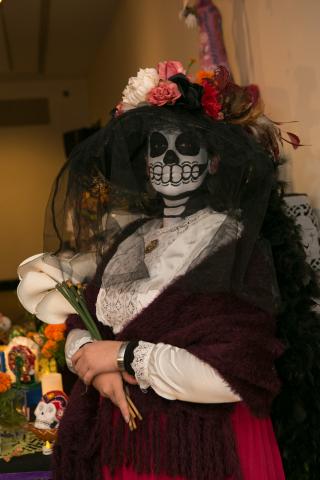
The free celebrations are open to the community and feature traditional ofrendas, dancing, poetry, music, and art activities.
EUGENE, Ore. -- (October 17, 2016) – This year's Día de los Muertos (Day of the Dead) celebration returns to the Jordan Schnitzer Museum of Art on the University of Oregon campus for four days of activities on Saturday, October 29, Sunday, October 30, Tuesday, November 1, and Wednesday, November 2, from 6:00 to 9:00 p.m. each evening.
This year's celebration —El Quijote de la Muerte— is dedicated to the 400th anniversary of the publication of Miguel de Cervantes' Spanish novel "Don Quixote." The free celebrations are open to the community and feature dancing, poetry, music, traditional Mexican ofrendas, artist talks, and art activities.
Each evening, Los Pitayeros, a traditional, stringed instruments, mariachi group from Jalisco, Mexico, will be joined by four dancers from Identidad y Folclor, based in Guanajuato, Mexico, for a lively performance. One of Mexico's award-winning artists, Raymundo González Nieto, will present an exhibition of his papier mâché skeleton figures and lead art-making activities in the museum's education studio. In addition to the evening events, JSMA has produced a guide to artworks on view in the museum's galleries that relate to the traditions of Day of the Dead, which is available in English and Spanish.
Constructed by the students of Oak Hills School and MEChA UO, traditional Día de los Muertos ofrendas (also known as Day of the Dead altars), will be on display. The altar is a customary part of the holiday that is meant to honor the deceased.
"Día de los Muertos is a festive and thoughtful holiday in Mexico and some parts of Central and South America," says Cheryl Hartup, JSMA associate curator of Latin American Art The unique tradition is celebrated by Latinos and Chicanos in the United States, and an ever-increasing general public."
Thousands of years ago, in the valley of southern Mexico, Mayas, Zapotecas, Mixtecas, and Aztecas honored their dead with elaborate ceremonies, dances and rituals. After Cortez conquered Mexico in the 16th century and with the introduction of Catholicism, the religious celebrations of All Saints Day and All Souls Day coincided with the indigenous Mexican celebrations. The intersection of these celebrations has given way to the Día de los Muertos that we know today, which includes the tradition of altars with food, art, candles, flowers, and photographs of the deceased alongside those of saints.
In Mexico, there are wide variances of this celebration between regions. However, traditionally on November 1, Día de los Muertos Chiquitos is observed to honor departed children. This evening is also sometimes referred to as la Noche de Duelo (The Night of Mourning) and is marked by a candlelight procession to the cemetery. On November 2, Día de los Muertos, the spirits of the dead are remembered. Entire families gather together to visit the graves of their ancestors.
The day is passed cleaning and decorating the gravesites of the departed, and time is spent together as a family and as a community. Families bring the favorite foods and libations of their loved ones to the gravesites, along with a picnic lunch for themselves. Sugar skulls and toys are given to the children, which emphasize early on that death is a positive and important part in the cycle of life. This is a happy celebration for families to remember the pleasant times shared with departed family members.
This event is co-sponsored by Oak Hill School in conjunction with the Jordan Schnitzer Museum of Art, MEChA de UO, Adelante Sí, el Instituto de Cultura de Guanajuato, el Instituto Estatal de Migrante Guanajuatense y sus familias, and CBT Nuggets.
About the Jordan Schnitzer Museum of Art
The University of Oregon's Jordan Schnitzer Museum of Art is a premier Pacific Northwest museum for exhibitions and collections of historic and contemporary art based in a major university setting. The mission of the museum is to enhance the University of Oregon's academic mission and to further the appreciation and enjoyment of the visual arts for the general public. The JSMA features significant collections galleries devoted to art from China, Japan, Korea, America and elsewhere as well as changing special exhibition galleries. The JSMA is one of six museums in Oregon accredited by the American Association of Museums.
The Jordan Schnitzer Museum of Art is located on the University of Oregon campus at 1430 Johnson Lane. Museum hours are 11 a.m. to 8 p.m. Wednesdays, and 11 a.m. to 5 p.m. Thursdays through Sundays. Admission is $5 for adults and $3 for senior citizens. Free admission is given to ages 18 and under, JSMA members, college students with ID, and University of Oregon faculty, staff and students. For information, contact the JSMA, 541-346-3027.
About the University of Oregon
The University of Oregon is among the 108 institutions chosen from 4,633 U.S. universities for top-tier designation of "Very High Research Activity" in the 2010 Carnegie Classification of Institutions of Higher Education. The UO also is one of two Pacific Northwest members of the Association of American Universities.
Contact: Debbie Williamson Smith, 541-346-0942, debbiews@uoregon.edu
Links: Jordan Schnitzer Museum of Art, http://jsma.uoregon.edu






